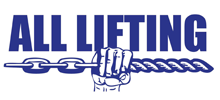
EXTENSIVE GUIDE TO TURNBUCKLES & RIGGING SCREWS
Turnbuckles and rigging screws are devices used in the lifting industry for tensioning and adjusting the length of wire rope. These devices normally consist of a metal frame with two eye bolts; one at each end, where the tension of the wire rope can then be adjusted by rotating the frame.
The most popular commercial turnbuckles are made from cast or forged steel in galvanized finish, which is very popular in the fencing industry. Therefore these devices are not built for the use of lifting and/or high-tension applications. You will be able to find different variations of these types of turnbuckles in the marketplace including, eye and eye, hook and eye, stub and stub and hook and hook.


At All Lifting, we carry a whole range of turnbuckles that will help you complete your job or project.
On the other hand, rated rigging screws are long devices formed from tubular sections of steel and can have an almost infinite size range and length adjustment. They are generally extended with either eye or clevis fittings which form the connection to different components such as shackles, wire rope assembles or anchor points.
When comparing turnbuckles and rigging screws, they have the same application, however the sizes may vary with shorter adjustments. The advantage of a turnbuckle is that it has a greater ability to be tightened under load as well as providing means for locking while in service.
Things that you should consider.
- Make sure that the correct device is selected for intended use and application.
- Where components are connected to turnbuckles or rigging screws, ensure they do not bind and freely articulate so that the system can sit in a straight line when tension is applied.
- When tensioning the body of a turnbuckle or rigging screw ensure that both end terminals and fittings do not rotate.
- Do not tension turnbuckles or rigging screws beyond the specified rating especially smaller sizes.
- Turnbuckles and rigging screws are not designed for continuous adjustment under rated load conditions therefore wear on the threads should be considered if used in this way.
- Locknuts, fitted to the ends of the body, are a method of locking, but may not provide positive or reliable locking under all circumstances therefore should be inspected regularly.
- High temperatures will affect the W.L.L of the turnbuckle and rigging screw; also, extremely low temperature applications may present a high risk of failure while loaded below the W.L.L. Therefore, you should always consult with a specialist about what temperatures you are intending to use the devices.
- Turnbuckles and rigging screws should be inspected periodically by a competent person.
These types of devices work alternatively with wire ropes grips; the reason for this is because grips are necessary to hold the wire rope. If you require any more information related to these devices; do not hesitate to contact us on info@alllifiting.com.au or phone 1300 666 733.


